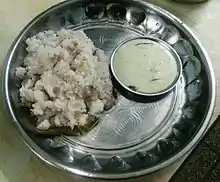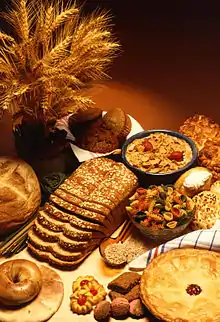Upma
Upma, uppumavu or uppittu is a dish originating from the Indian subcontinent, most common in Kerala, Andhra Pradesh, Tamil Nadu,[1]Karnataka, Maharashtrian, Gujarat, Odia and Sri Lankan Tamil breakfast, cooked as a thick porridge from dry-roasted semolina or coarse rice flour.[2] Various seasonings and/or vegetables are often added during the cooking, depending on individual preferences. Today it is popular in most parts of India and is prepared in various ways.
 Upma | |
| Alternative names | Uppuma, Uppittu, Uppumavu, Uppindi, Kharabath, Upeet, Rulanv |
|---|---|
| Course | Breakfast |
| Place of origin | India |
| Main ingredients | Semolina or coarse rice flour |
Etymology
The different names for the dish derive from the combinations of the word uppu, meaning salt[3] in many Dravidian languages, Indo-Aryan languages and various words for flour: like pindi[4] or mavu.[5] In North India, the dish is called upma. In Maharashtra the dish traditionally had the name saanja in Marathi.
| Language | Roman Transliteration | Native Unicode |
|---|---|---|
| Telugu | Upma, uppindi | ఉప్మా, ఉప్పిండి |
| Gujarati | Upma | ઉપમા |
| Kannada | Uppittu, kharabath | ಉಪ್ಪಿಟ್ಟು, ಖಾರಬಾತ್ |
| Tamil | uppuma | உப்புமா |
| Malayalam | Uppumavu | ഉപ്പുമാവ് |
| Marathi | Saanja, uppeet, upma | सांजा, उप्पीट/उपमा |
| Konkani | Rulanv | रुलांव |
| Hindi | Upma | उपमा |
| Odia | Upma | ଉପମା |
| Bengali | Upma | উপমা |
| Nutritional value per 120 gm | |
|---|---|
| Energy | 1,046 kJ (250 kcal) |
45.67 | |
| Dietary fiber | 3.2 g |
3.78 | |
| Saturated | 0.916 g |
| Monounsaturated | 1.54 g |
| Polyunsaturated | 0.944 g |
8.11 | |
| Minerals | Quantity %DV† |
| Potassium | 5% 223 mg |
| Sodium | 13% 190 mg |
| |
| †Percentages are roughly approximated using US recommendations for adults. | |
Ingredients and preparation
Upma is typically made by first lightly dry roasting semolina (called rava or sooji in India). The semolina is then taken off the fire, and kept aside while spices, lentils, onion, ginger, etc are sautéed in oil or ghee. The semolina is then added back to the pan and mixed thoroughly. Boiling water is added, and the mixture is stirred until the semolina absorbs the liquid and becomes fluffy in texture.[6][7]
There are several ways in which upma is made, and the variations are obtained by either adding or removing spices and vegetables. The texture can vary significantly as well, depending on how much water is added to it, and how long the mixture is allowed to remain on the flame thereafter.
Major variations
Sooji upma

The most popular version with wide variations of upma are made with whole or refined ground semolina made out of durum wheat. Sometimes a wide range of vegetables may be added, and may be garnished with a variety of beans (raw or sprouted), cashew and peanuts. For a variation called masala upma (known as kharabath in Karnataka), sambar masala or garam masala is added along with red chilli powder, instead of green chillies. This variety is more popular in Karnataka, Maharastra, Tamil Nadu and parts of Andhra Pradesh and is usually served in South Indian restaurants. Uppumavu paired with hand mashed banana is a common breakfast item in Kerala homes.
Whole wheat upma

Whole wheat or wheat dalia (cracked wheat) is a common variation of upma in Tamil Nadu, where it is eaten for breakfast or dinner. Sometimes it is cooked with vegetables like peas, carrots, and beans.
Upma Pesarattu
Upma Pesarattu is the most popular version in Andhra Pradesh, Yanam and Telangana. The dish contains Upma and Pesarattu combined. The upma is eaten by wrapping it in the Pesarattu.[8][9]
Rice upma

Rice upma, which is mainly popular in Tamil Nadu and southern parts of Karnataka, is referred to as akki tari uppittu (rice coarse flour uppittu). Another variant of upma is prepared with grated coconut instead of onions, especially on holy days, when onion is avoided. This type of upma is generally smeared with ghee at the end of preparation. Dishes similar to upma can be made by substituting small crumbs of leftover bread or idli instead of flour. Upma made from coarser rava known as sajjige is a dish of Udupi cuisine. It is sometimes served along with snacks such as sautéed and spiced poha or chevdo.
Corn upma

Another variation, particularly as a breakfast dish, is corn upma, eaten with milk and nuts.[10]
Kesari bhath
In Karnataka, upma is also served with another common sweet dish of Karnataka, kesari bhath (ಕೇಸರಿ ಬಾತ್), with a scoop of each on one plate, in a presentation commonly called "chow chow bath".
Aval upma/Atukula upma
In Kerala & Andhra Pradesh, upma made with flattened rice in substitution to semolina this dish is popularly called as Aval upmavu in Malayalam (അവൽ ഉപ്പുമാവ്) & Atukulu upma (అటుకులు ఉప్మా) in Telugu. This variant is also known as aval upma in the Chennai region when made with rice flakes similar to poha.
Vermicelli upma

A popular light evening snack is upma made with vermicelli and tomato, peas and carrot.
See also
- List of porridges
- Broken rice
- Couscous
 Food portal
Food portal
References
- Pandya, M. (1985). Indian Vegetarian Cooking. Inner Traditions/Bear. p. 164. ISBN 978-0-89281-342-1. Retrieved 26 January 2018.
- "Poha or upma? Shabana Azmi and Twitter divided over breakfast dish". Hindustan Times. 9 October 2017.
- "English Meaning of uppu - Online Tamil to English Dictionary & Vocabulary - English Meaning for Tamil Words". www.tamildictionary.org. Retrieved 24 June 2019.
- "English Meaning of - Free Online Telugu to English Dictionary | Free Telugu to English Dictionary Software, Downloads, Converter, Translation, Transliteration". telugudictionary.telugupedia.com. Retrieved 24 June 2019.
- Burrow, T. (Thomas); Emeneau, M. B. ; 1904-; (Murray Barnson) (1984). "A Dravidian etymological dictionary". dsalsrv04.uchicago.edu. Retrieved 24 June 2019.
- Dubey, Krishna Gopal (27 September 2010). THE INDIAN CUISINE. PHI Learning Pvt. Ltd. ISBN 9788120341708.
- "Upma: Here's All You Need To Know About The Traditional Indian Breakfast Dish". NDTV Food. Retrieved 24 June 2019.
- Chef and Her Kitchen. "MLA Pesarattu ..aka.... Upma Pesarattu....Andhra's Signature Recipe". Retrieved 19 September 2020.
- "Upma Pesarattu Dosa (Traditional Andhra Breakfast) recipe | Breakfast recipes | Bethica Das recipes". RecipeBook. Retrieved 19 September 2020.
- Dalal, Tarla (28 October 2003). Healthy breakfast. Mumbai: Sanjay. p. 9. ISBN 9788186469811.
| Wikimedia Commons has media related to Upma. |



